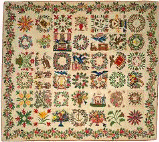Textile Society of America
Date of this Version
9-2012
Citation
Published in Textiles and Politics: Textile Society of America 13th Biennial Symposium Proceedings, Washington, DC, September 18- September 22, 2012.
Abstract
Michel Garcia’s workshop The Many Shades of Cochineal Red at the in Arlington Arts Center in Arlington, Virginia, was packed with multiple steaming pots, a couple of blown fuses and multiple vibrant hues of red, purples and oranges. Garcia demonstrated how the selection of mordanting processes used in conjunction with cochineal dye resulted in different nuances of the color red in the final dyed cloth and yarn. As a bonus and demonstration of other reds from natural dyes, Garcia also used madder to dye more fiber.
The three mordanting methods outlined by Garcia were what he called the classical method, the forgotten method and the unknown method. The classical method uses the mineral salt alum (aluminum sulfate) and cream of tartar to mordant the fiber. The forgotten method uses bio-accumulators of Aluminum in place of mineral salts as a mordant. This method was in use in some countries until the 18th century. Both the classical and forgotten methods require that the fiber be mordanted separately before being dyed in a cochineal bath. The third or unknown method is a one-bath process using plant tannins and citric acid together with the cochineal all at the same time.
The classical mordanting method of mineral alum (15% weight of fiber/WOF) with an addition of cream of tartar (6% WOF) simmered and then dyed in the cochineal bath produced a rosy red on wool gauze and cool blue-toned purple-red on felted wool and wool yarn. A bonus dye bath on silk produced a deep rose pink.


Comments
Copyright 2012 by the author(s).